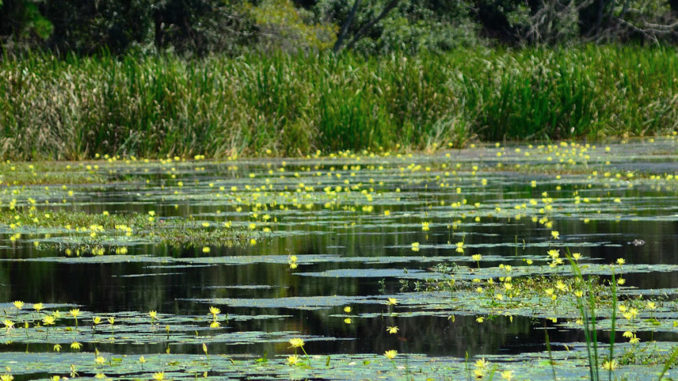
Moist-soil management trumps impoundments
Each fall and winter, flooded areas along the eastern seaboard get bombarded by the annual migration of waterfowl, and duck hunters are always on the prowl for new ways to get more birds into shooting range. From new calls and revolutionary decoying devices to the various grain mixes planted in impoundments that are temporarily flooded, hunters are always going to the drawing board, devising plans to improve their hunting experiences. But the typical dry-land impoundment may not always be the best way to attract and retain a substantial portion of the migrating flock at the time when it matters most.
For years, the typical agriculture field with perimeter dikes and a reliable water source has been the ideal setup to get a visit from the migrating flock. And no doubt, these dry-land impoundments can be super duck magnets if planted correctly and controlled effectively. Ducks are suckers for fields flooded with carbohydrate-filled grains, yet, the majority of these impoundments only provide a temporary food source that often gets depleted quickly. And since they are only flooded for a short period of time, these fields are only important to ducks on a part-time basis, with a very limited grocery selection available.
Land managers with specific areas of their property capable of complete dedication to waterfowl have a real opportunity to make their property more appealing through permanent impoundments. Landowners can convert the temporary flood regimes — or at least a portion of them — over to more of a permanent situation to promote more of an aquatic-type community. Varying the water level and retaining some areas flooded and others in a “moist” condition is referred to as a “moist-soil management” regime.
In a typical setting, moist-soil management incorporates a method of flooding that keeps the soils moist in the summer for propagating aquatic or wetland plants and then producing a full flood in the cool season during the waterfowl migration.
While permanent or semi-permanent flooding eliminates the propagation of annual cereal grains, persistent water coverage creates a perpetual and reliable food source covering a larger component of the food pyramid. And more food means more ducks!
Aquatic communities provide a more diverse nutritional structure in both the animal and the plant community that are critical dietary components for wintering and migrating species. Flooded corn and other cereal grains only provide ducks with a limited supply of carbohydrate-rich seed, and when that seed is gone, so are the ducks. The aquatic plant community opens up the menu to a much wider selection of plant parts that ducks can consume, including the leaves, stems, roots, tubers and of course, any seed pods that may develop. Additionally, aquatic plant species are fairly aggressive and will propagate quickly even from heavy browsing that will provide more food for ducks throughout the season and well afterwards.
Beyond typical plant parts, aquatic systems have a well-developed animal community, including a list of invertebrates and vertebrates that provide an important protein source for puddle ducks and divers.
Providing a perpetual aquatic habitat for waterfowl can set these properties on an upward trend for improved hunting. Ducks have good memories that can be an asset for landowners with optimal habitat. The North American flock spends its summers in Canada and the extreme northern reaches of the United States, and the winter migration will spread ducks from just below the Mason-Dixon Line all the way to Mexico. Luckily, not all of the ducks end up in a Mexican pothole. Many ducks winter throughout the southern states.
The migration begins during the early fall and continues through the end of the year. By January, the migrating flocks have arrived in their winter havens and will stay put unless hunting pressure or a winter lock-up pushes them further south. At some point in the late winter and early spring, the migrating flocks retrace their steps back to Canada making stops along the way. Again, ducks have a good memory and will return to the places with a good food source and an overall good experience. For this reason, areas that are permanently flooded train migrating flocks to hopefully return the next season.
So what makes the best permanent impoundment? First, you must have the ability to control the water depth with little to moderate effort. Some of the best places are impoundments that are already low on the landscape and are susceptible to recurrent flooding from an above-average rain event during the warm season. On the other hand, leaky impoundments that require perpetual flooding throughout the season are poor candidates.
For some landowners lacking the ability to control the water depth in places like swamps, depressions and even beaver ponds is not always the “no-go” situation. In fact, Mother Nature knows exactly when to raise and lower water levels during a normal year. They rise during the fall and then eventually recede during the warmer spring and summer, allowing a wide variety of seeds to germinate and grow in time for the fall flood.
If duck impoundments have progressed through another season without the level of satisfaction that hunters expect, it may be time to convert seasonal impoundments into permanent moist-soil management units. For more information about these duck impoundments, contact me at *Southern Palmetto Environmental Consulting (843-685-2408).




Be the first to comment